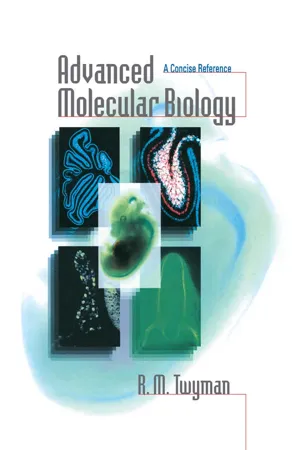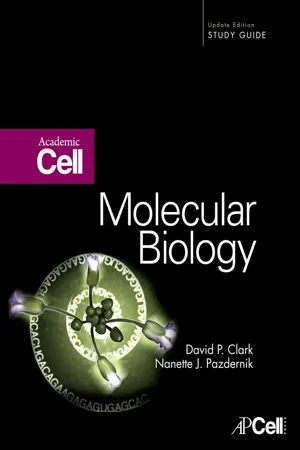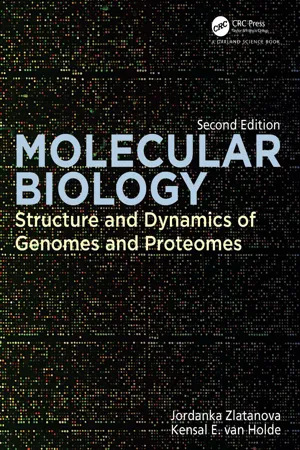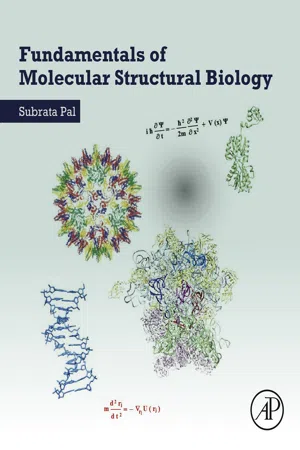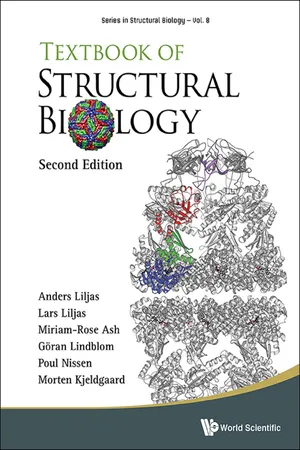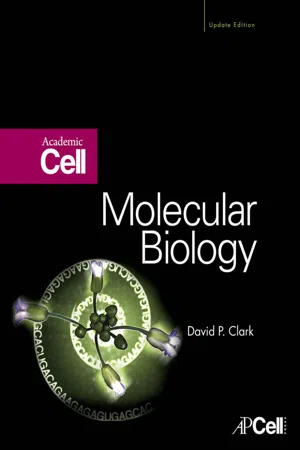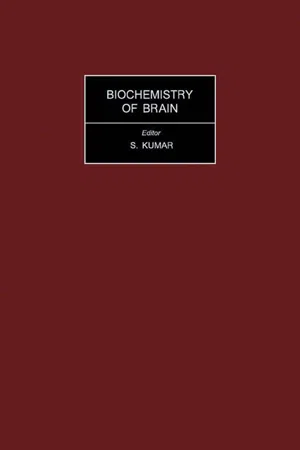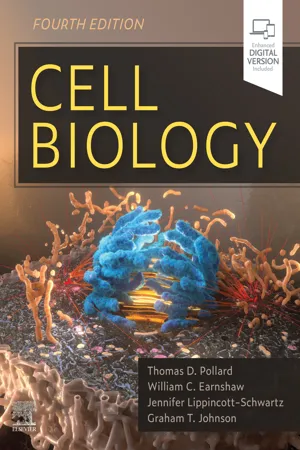Chemistry
transfer RNA
Transfer RNA (tRNA) is a type of RNA molecule that plays a crucial role in protein synthesis. It carries specific amino acids to the ribosome, where they are added to the growing protein chain during translation. Each tRNA molecule has an anticodon that pairs with a complementary codon on the messenger RNA, ensuring the correct amino acid is incorporated into the protein.
Written by Perlego with AI-assistance
Related key terms
12 Key excerpts on "transfer RNA"
- eBook - ePub
Advanced Molecular Biology
A Concise Reference
- Richard Twyman(Author)
- 2018(Publication Date)
- Garland Science(Publisher)
petidyltransferase domain, which provides the catalytic activity for peptide bond formation, and a GTPase domain, whose activities are required for translocation of the ribosome along the mRNA. The roles of these sites during protein synthesis are discussed in more detail below.transfer RNA. Before the genetic code (q.v.) was understood, Francis Crick proposed the adaptor hypothesis to explain how the nucleotide sequence in mRNA could be translated into protein. The model predicted the existence of an adaptor molecule which would recognize both the nucleic acid sequence of the message and the appropriate amino acid, bringing the two together at the ribosome.The adaptor molecule is transfer RNA (tRNA). The tRNAs are a relatively homogeneous family of RNA molecules, usually 75–100 nucleotides in length, which are extensively processed during their production (see RNA Processing). They possess a characteristic secondary and tertiary structure (Box 23.2 ), most importantly the acceptor stem (to which the amino acid binds) and the anti-codon loop (which carries the three nucleotide anticodon that forms complementary base pairs with codons in the mRNA). Bacterial cells contain up to 35 different tRNAs, and eukaryotic cells up to 50. This number is lower than the number of possible codons in the genetic code, but greater than the number of amino acids specified by the code. This indicates that individual tRNAs can recognize more than one codon (reflecting wobble pairing, q.v), but that different tRNAs may be charged with the same amino acids (these are isoaccepting tRNAs, q.v.).The tRNAs are charged (conjugated to their corresponding amino acids) by enzymes termed amino acyl tRNA synthetases. There is one enzyme for each amino acid, and therefore each synthetase recognizes all its cognate isoaccepting tRNAs. The charging mechanism and its regulation are considered in detail elsewhere (see - eBook - ePub
Molecular Biology
Academic Cell Update Edition
- David P. Clark(Author)
- 2012(Publication Date)
- Academic Cell(Publisher)
8 Protein SynthesisSummary
In the central dogma, after a gene is transcribed into RNA, it is next converted to protein. As we saw in the last chapter, proteins are one of the key components to cellular function. Translation is the act of converting mRNA into a protein by protein/RNA machines called ribosomes. In order to convert a nucleotide sequence into amino acid sequence, there has to be a code. In translation the code is based upon three adjacent nucleotides which are recognized as one by transfer RNA (tRNA) called a triplet codon.tRNA is simply a piece of RNA with some modified bases that has folded back to form three different stem-loop structures. There are three ribonucleotides on one end called the anticodon, which is where it recognizes the mRNA codon. At the opposite side, an amino acid attaches to the acceptor stem. The anticodon has less physical constraint since it is at the top of the loop, therefore, the first anticodon nucleotide can base pair with different mRNA nucleotides than the standard. This wobble position allows more than one triplet codon to encode the same amino acid, called a degenerate code. There are special group of enzymes called aminoacyl tRNA synthetases that recognize each specific uncharged tRNA. The active site of the aminoacyl tRNA synthetase recognizes the anticodon and other telltale nucleotides of the tRNA, brings the correct amino acid into proximity of the acceptor stem, and connects them. There is a specific aminoacyl tRNA synthetase for each tRNA/amino acid pair.Ribosomes are a combination of rRNA and proteins. These molecular machines have two major subunits that provide a scaffold for tRNA to bind and then catalyze the peptide bond between two adjacent amino acids. In bacteria, the 70S ribosome has a 50S (large) subunit and 30S (small) subunit; in eukaryotes, the 80S ribosome has a 60S and 40S subunit. Forming the peptide bond between amino acids is done by the 23S rRNA which makes this a peptidyl transferase enzyme. RNA that catalyzes enzyme reactions is called a ribozyme. - eBook - ePub
Molecular Biology
Structure and Dynamics of Genomes and Proteomes
- Jordanka Zlatanova(Author)
- 2023(Publication Date)
- Garland Science(Publisher)
Translation: The PlayersDOI: 10.1201/9781003132929-15Learning objectivesTranslation is the process by which messenger RNA chains are read to yield protein chains. Translation requires both RNA–RNA and RNA–amino acid recognition. The three major players in translation are the mRNA that carries the message, the tRNA (adaptor) molecules that carry the amino acid specified by the next codon in the mRNA, and the ribosome, the active platform on which the process occurs.tRNA molecules carry both an anticodon that matches the codon on the message and the amino acid that is specified by that codon. The charging of tRNAs with amino acids is catalyzed by a set of enzymes called aminoacyl-tRNA synthetases. In this two-step process, the amino acid is first activated by adenylation and then attached to the acceptor end of the corresponding tRNA. Various modes of proofreading ensure the fidelity of matching the amino acid with the appropriate tRNA.Functional ribosomes in all cells are composed of two subunits, designated by their sedimentation coefficients: 30S and 50S subunits give rise to 70S ribosomes in bacteria and archaea, while 40S and 60S subunits form 80S ribosomes in eukaryotes. Each ribosome contains several RNAs and many proteins, which form three tRNA-binding sites shared between the large and small subunit. During elongation, tRNA is transferred between these sites in a unidirectional manner. Ribosome biogenesis is a complicated multistep process that requires coordinated synthesis of several RNA molecules and the whole set of ribosomal proteins. Assembly of eukaryotic ribosomes requires additional RNA processing and auxiliary protein factors.Initiation of translation occurs via different mechanisms in bacteria and eukaryotes. Bacteria use a special sequence (known as the Shine–Dalgarno, SD, sequence) located near the 5′-terminus of the mRNA: SD base-pairs with a sequence in the 16S rRNA of the small ribosomal subunit. In eukaryotes, the ribosome attaches near the cap and hunts downstream for the first methionine codon. Finally, termination of translation involves both specific stop codons and termination factors that bind to the ribosome instead of tRNAs. - eBook - ePub
- Subrata Pal(Author)
- 2019(Publication Date)
- Academic Press(Publisher)
Chapter 11Translation
Abstract
Translation is a process in which genetic information carried in messenger RNA (mRNA), in the form of ribonucleotide triplets or codons, is transferred to protein as a linear sequence of amino acids (polypeptide). transfer RNA (tRNA) provides the physical interface between the amino acid to be incorporated into a growing polypeptide chain and the mRNA. For this purpose, the amino acid is linked to its cognate tRNA by aminoacyl-tRNA synthetase. A translation machinery, assembled in a huge ribonucleoprotein complex called the ribosome, begins translation at the start codon (initiation), proceeds one codon at a time along a string of nonoverlapping codons (elongation), and terminates at the stop codon (termination). Initiation is certainly the most intricate stage in translation. In each elongation step, an amino acid is added to a growing polypeptide chain by the formation of a peptide bond. At termination, the nascent polypeptide chain is released from the ribosomal complex. The entire process of translation is dependent on numerous factors, both RNA and protein.Keyword
Codon; mRNA; tRNA; rRNA; Amino acid; Aminoacyl-tRNA synthetase; Initiation; Elongation; TerminationOnce genetic information, carried in DNA in the form of a linear sequence of four deoxyribonucleotide bases (A, T, G, C), has been transferred to messenger RNA (mRNA) as a linear sequence of four ribonucleotide bases (A, U, G, C), the task of the cell is to “forward” the message to another macromolecule, protein, in the form of a linear sequence of 20 amino acids. Therefore, we shall discuss, in this chapter, a process in which the 4-letter language of RNA is “translated” into the 20-letter language of protein. This process is called translation. - Naoki Sugimoto(Author)
- 2021(Publication Date)
- Wiley-VCH(Publisher)
It is synthesized as precursor tRNA and maturated through several processing reactions, such as endonucleolytic cleavage, splicing, and chemical modifications of nucleobases, depending on each tRNA. The mature tRNA is typically 73–90 nt long and has well-conserved cloverleaf secondary structure and L-shaped tertiary structure (Figure 7.3a and b). tRNA has been utilized as a model for physicochemical studies of RNA structure and stability. The substantive substrate for the translation reaction is an aminoacyl-tRNA, in which 3′ end of tRNA is covalently attaching an amino acid (Figure 7.3c). An organism has at least 20 kinds of tRNA molecules corresponding to 20 kinds of amino acids constructing proteins. Aminoacyl-tRNA synthetases, which are also existing at least 20 kinds, catalyze the reaction to attach the amino acid on the tRNA. A primary correlation between anticodon sequence in tRNA and the amino acid on its 3′ end ensures accurate decoding of genetic code (codon) into protein. Figure 7.3 Conserved secondary and tertiary structures of tRNA. (a) Secondary cloverleaf structure. Anticodon triplet is located at the bottom hairpin loop. (b) Tertiary L-shaped structure. (c) Chemical reaction of aminoacylation. Amino acid is covalently attached on 3′ end of tRNA through formation of ester bond catalyzed by aminoacyl-tRNA synthetase. rRNA is the most abundant RNA in cells, which accounts approximately 80–90% weight of total RNA in mammalian cells [ 1 ]. The second abundant is tRNA, which accounts approximately 10–15% of total weight. Initial precursor transcript of rRNA is posttranscriptionally processed into several kinds of mature rRNAs (16S, 23S, and 5S rRNAs in prokaryotes and 18S, 5.8S, and 28S rRNAs in eukaryotes). It is noted that 5S rRNA in eukaryotes is transcribed separately- Tina M. Henkin, Joseph E. Peters(Authors)
- 2020(Publication Date)
- ASM Press(Publisher)
genetic code .The actual translation from the language of nucleotide sequences to the language of amino acid sequences is performed by small RNAs called tRNAs and enzymes called aminoacyl-tRNA synthetases (aaRSs). The aaRS enzymes attach specific amino acids to their matching tRNAs. Each aminoacylated tRNA (aa-tRNA) specifically pairs with a codon in the mRNA as it moves through the ribosome, and the amino acid carried by the tRNA is added to the growing protein. The tRNA pairs with the codon in the mRNA through a 3-nucleotide sequence in the tRNA called the anticodon that is complementary to the codon in the mRNA. The base-pairing rules for codons and anticodons are basically the same as the base-pairing rules for DNA replication, and the pairing is antiparallel. The only major differences are that RNA has uracil (U) rather than thymine (T) and that the pairing between the last of the 3 bases in the codon and the first base in the anticodon is less stringent.This basic outline of gene expression leaves many important questions unanswered. How does mRNA synthesis begin and end at the correct places and on the correct strand in the DNA? Similarly, how does translation start and stop at the correct places on the mRNA? What actually happens to the tRNA and ribosomes during translation? What happens to the mRNA and proteins after they are made? The answers to these questions and many others are important for the interpretation of genetic experiments, so we will discuss the structure of RNA and proteins and the processes by which they are synthesized in more detail.- eBook - ePub
- Anders Liljas, Lars Liljas;Miriam-Rose Ash;G?ran Lindblom;Poul Nissen;Morten Kjeldgaard(Authors)
- 2016(Publication Date)
- WSPC(Publisher)
An important aspect of protein synthesis is that nucleic acid molecules have central roles, in contrast to most other processes in cells where proteins dominate. Central components are the mRNA, the tRNA and the ribosomal rRNA molecules. An mRNA molecule contains a copy of the gene sequence and binds to the ribosome. The tRNA molecules, the adapters suggested by Francis Crick, decode the gene sequence and link the amino acid into the growing peptide on the ribosome.Fig. 11.1 ▪ The universal genetic code. The trinucleotide codons are translated to the 20 amino acids, given here with their three and one letter codes.11.1.1The Genetic Code and the tRNAs
The base triplets of the genetic code (Figure 11.1 ) that build up a messenger rRNA (mRNA) are called codons and correspond to the 20 different amino acids. In addition, there are normally three stop codons (UAA, UAG and UGA). The synthesis of a protein normally starts at an AUG codon, which is also the codon for methionine. Special systems have developed to differentiate between ordinary methionine codons and the start signal, the initiation codon. In some cases (methionine, tryptophan), there is only one triplet that codes for a certain amino acid, but sometimes there are as many as six (serine, leucine, arginine). The code is degenerate. There is no one-to-one relationship between codons and tRNA molecules. Mammalian mitochondria have a very limited set of tRNA molecules, but many species have around 40. This relates to the variable codon usage as well as to the capacity of some tRNAs to read several codons (tRNA wobble base-paring).The tRNA molecules are normally around 75 nucleotides long (Section 5.3.10.1 ). The secondary structure looks like a cloverleaf with a stem and three leaves (Figure 5.47 ). The stem has the unique sequence CCA at the 3′-end. It is the ribose of the 3′-terminal A that gets aminoacylated by specific enzymes, tRNA synthetases. This stem is therefore called the aminoacyl or acceptor stem. The three leaves or arms of the tRNA are called the D stem and loop, the anticodon stem and loop, and the T stem and loop, respectively. In addition, there is a variable loop (V-loop) that can be upto 21 nucleotides in length. Serine and leucine tRNAs generally have long V-loops as does tyrosine tRNA in bacteria and chloroplasts. The anticodon at the end of the middle loop can match a codon in the mRNA. The three-dimensional structure of the tRNA molecule has the shape of an “L” (Figure 5.47 - eBook - ePub
- David P. Clark(Author)
- 2009(Publication Date)
- Academic Cell(Publisher)
Figure 8.03 transfer RNA Recognizes CodonsSeveral tRNAs are seen bound to mRNA codons by their anticodons. Each tRNA carries a different amino acid at the end of the adaptor stem. This diagram is intended to show the principle of mRNA decoding. It does NOT illustrate the actual mechanism of protein synthesis. In real life, the codons are contiguous and there are no spacers in between and only two tRNAs are bound at any given time.The anticodon of tRNA recognizes the codon on mRNA by base pairing.Each transfer RNA carries one particular amino acid.transfer RNA Forms a Flat Cloverleaf Shape and a Folded “L” Shape
transfer RNA molecules are about 80 nucleotides in length. About half the bases are paired to form double helical segments. A typical tRNA has four short base-paired stems and three loops (Fig. 8.04 ).This is shown best in the cloverleaf structure , intended to reveal details of base pairing, which shows the tRNA spread out flat in only two dimensions. (Such a diagram is sometimes called a secondary structure map). The tRNA cloverleaf is folded up further to give an L-shaped 3-D structure, in which the TΨC-loop (or T-loop) and the D-loop are pushed together. The anticodon and attached amino acid are located at the two ends of the L-structure. Different tRNA molecules vary considerably in sequence, but they all conform to this same overall structure. Variations in length (from 73 to 93 nucleotides) occur, due mostly to the variable loop.Figure 8.04 - eBook - ePub
- Sudhir Kumar(Author)
- 2013(Publication Date)
- Pergamon(Publisher)
*O.Z. SELLINGER and C.E. SALAS† , Laboratory of Neurochemistry, Mental Health Research Institute, University of Michigan Medical Center, Ann Arbor, Michigan 48109Publisher Summary
This chapter discusses the presence of transfer RNAs (tRNAs) in brain. There is a general agreement among tRNA-philes that this family of macromolecules lies squarely astride the crossroads linking polynucleotides to polypeptides and that the principal role of tRNA in any cell is to make possible cell-specific protein synthesis. In addition to its well-known role as a specific acceptor molecule for amino acids engaged in cellular protein synthesis, tRNA intervenes in the regulation of protein synthesis in specialized cells, which produce larger amounts of a particular protein as a norm or which exhibit such tendencies under special circumstances during their life cycle. In a given tissue, the relative amounts of each free or aminoacylated tRNA are directly related to the amino-acid composition of the proteins synthesized in that tissue. The chapter describes an earlier study in which both the levels and the proportion of individual tRNA to the total tRNA population in rat and mouse brains were found to vary rather widely during early postnatal development. The observed changes could not be correlated with changes in the concentration of the cognate-free amino acids.CONTENTSIntroduction Purification of tRNA Characterization of tRNAA. Column chromatography B. Gradient centrifugation and electrophoresisIsoacceptor tRNAs Processing of tRNA Methylation of tRNA Other tRNA Modifications Special Functional Aspects Effects of Hormones, Drugs and Elicited States Final Remarks ReferencesINTRODUCTION
The purpose of this review is to update the neurochemical research done on brain transfer RNA (tRNA) over the past few years and by doing so to glean at the possible special function(s) it may have in the highly specialized cells of the mammalian nervous system. To the authors’ knowledge, this is the first review of the subject and for this reason its appearance may be either premature or belated, depending on the readership’s perception of its timeliness. As far as possible, the chapter will deal with nervous tissue tRNA (Mahler et al ., 1966; Mandel & Jacob, 1971 - eBook - ePub
Single-Particle Cryo-Electron Microscopy
The Path Toward Atomic Resolution/ Selected Papers of Joachim Frank with Commentaries
- Joachim Frank(Author)
- 2018(Publication Date)
- WSPC(Publisher)
The ribosome is a very large (2.4 MDa in eubacteria) ribonucleic-protein complex composed of two distinct subunits, the small subunit (30S) charged with the task of decoding the genetic message carried by the messenger RNA (mRNA), the large subunit (50S) to the catalysis of peptide bond formation. Instrumental for these fundamental processes is the interaction of the ribosome with transfer RNA (tRNA), a small L-shaped molecule that embodies in its various forms the association of each amino acid with a three-base “word” of the genetic code, the codon. Translation is based on the mutual recognition, by partial Watson–Crick pairing, between the codon on the mRNA and the anticodon of the tRNA carrying the corresponding amino acid. In facilitating tRNA selection, decoding, and the stepwise formation of the polypeptide, ribosomal RNA (rRNA) acts as both a structural framework and a catalyst.Despite the success in the elucidation of ribosomal structure by x-ray crystallography, the detailed mechanism by which translation of mRNA code into peptide proceeds is still only scantly understood. One of the obstacles we face is that although the process is complex and dynamic, x-ray crystallography represents the molecule in a static form—packed in a crystal, moreover, whose very stability depends on intermolecular contacts that are largely nonphysiological. Of crucial importance for the understanding of the multistep translation process is the knowledge of how the ribosome interacts with its ligands, notably (apart from the most crucial ligands mRNA and tRNAs) the various factors catalyzing initiation, elongation, termination, and recycling. To date, with the exception of ribosomal complexes containing eubacterial release (RF1 or RF2) (1 ) or recycling (RRF) (2 , 3 ) factors, there exists no x-ray structure of a factor–ribosome complex. The crystal structures of individual subunits complexed with initiation (4 –6 ) and recycling (7 - eBook - ePub
Advanced Chemical Biology
Chemical Dissection and Reprogramming of Biological Systems
- Howard C. Hang, Matthew R. Pratt, Jennifer A. Prescher, Howard C. Hang, Matthew R. Pratt, Jennifer A. Prescher(Authors)
- 2023(Publication Date)
- Wiley-VCH(Publisher)
Section 4.5 ) often share reagents and follow the same guiding principles as in DNA chemical synthesis and sequencing. Unlike DNA, which is generally found as a double helix in cells, RNA assumes diverse conformations with distinct chemical, biophysical, and functional properties. A single difference in the sugar molecule of the nucleotide building blocks of these two biopolymers – a 2′‐hydroxyl on the ribose ring of RNA – has substantial consequences on their respective conformations, stabilities, and reactivities. As we will explore in this chapter, these differences are reflected in the biological roles and functionalities of RNA.Consider a molecule of tRNA, the first high‐resolution structures of which were solved to 3 Å in 1974 [2 , 3 ]. The role of tRNA in protein synthesis is twofold: it both “reads” the triplet codon in an mRNA through a three‐base anticodon interaction and delivers the correct amino acid to the growing peptide chain. The codon–anticodon interactions found between the tRNA and mRNA can mostly be understood using the conventional base‐pairing rules previously described for DNA (A with U/T and G with C), but even in codon–anticodon recognition, there are examples of non‐Watson–Crick pairing (i.e. wobble pairs, see Section 4.2.2 ) and noncanonical bases (see Section 5.4.1 ). What is the chemical basis that ensures that a given tRNA will be charged with its appropriate corresponding amino acid? The mechanistic basis for successful mRNA decoding by tRNA is distributed across both the anticodon stem and other features spread across the 3D structure that are recognized by tRNA synthetases [4 , 5 - eBook - ePub
- Thomas D. Pollard, William C. Earnshaw, Jennifer Lippincott-Schwartz, Graham Johnson(Authors)
- 2022(Publication Date)
- Elsevier(Publisher)
www.rcsb.org ] file 1wkw.)Most eukaryotic mRNAs have a 3′ tail of 50 to 200 adenine residues added to the 3′ end after transcription (see Fig. 11.3 ). This poly(A) tail binds a protein that promotes export from the nucleus and protects the mRNA from degradation in the cytoplasm. The 3′ poly(A) tails are shorter or absent on bacterial mRNAs. Many mRNAs have regions that form double-stranded secondary structures (see Fig. 3.19 ) that must be disrupted during translation to allow reading of each codon.transfer RNA
tRNAs are adapters that deliver amino acids to the translation machinery by matching mRNA codons with their corresponding amino acids as they are incorporated into a growing polypeptide (see Fig. 12.7 ). One to four different tRNAs are specific for each amino acid, generally reflecting their abundance in proteins. Specialized tRNAs carrying methionine (formylmethionine in Bacteria) initiate protein synthesis. tRNAs consist of ∼76 nucleotides that base-pair to form four stems and three intervening loops (see Fig. 3.20 ). These elements of secondary structure fold to form an L-shaped molecule. A “decoding” triplet (the anticodon ) is at one end of the L (the anticodon arm), and the amino acid acceptor site is at the other end of the L (the acceptor arm) (Fig. 12.4A ).Figure 12.4 tRNA STRUCTURE AND AMINOACYL tRNA SYNTHETASES. transfer RNAs (tRNAs) match an amino acid attached at the 3′ end with the messenger RNA (mRNA) triplet coding for that amino acid. A, Space-filling model showing base pairing of the anticodon to an mRNA codon. Pairings between the anticodon and the first and second bases in a codon are strict (G:C and U:A), but pairing with the third base is more flexible. This “wobble” allows the ∼40 tRNAs found in most cells to match with the 61 sense codons in mRNA. B, Space-filling models of five tRNAs bound to their aminoacyl tRNA synthases. (Rendered from PDB files 6tna , 1ffy , 1gax , 1euq , 1qf6 and 1eiy
Index pages curate the most relevant extracts from our library of academic textbooks. They’ve been created using an in-house natural language model (NLM), each adding context and meaning to key research topics.
